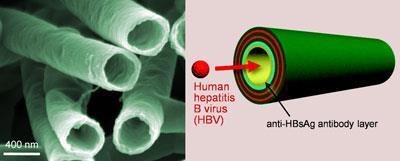Nanotubes made from human proteins used to ensnare hepatitis B
Japanese researchers have used nanotubes made from human blood proteins to trap hepatitis B virus (HBV). They say their work lays the foundations for a new chemistry of protein-based nanotubes with biomedical applications.
The term ’nanotubes’ is ordinarily used to refer to hollow, cylindrical carbon nanostructures. But a team led by Teruyuki Komatsu at Chuo University in Tokyo has developed a technique to build tiny tubular structures from natural proteins as opposed to carbon. Now, they show that these ’smart’ nanotubes can be used to selectively trap infectious virus particles.1

’Our nanotubes composed of proteins, [including] enzymes and antibodies, are very unique,’ says Komatsu. The tubes consist largely of human serum albumin, the major plasma protein in human blood. They are fashioned by filling a polycarbonate template layer-by-layer with polymers and proteins. The tricky part is ensuring the nanotubes don’t lose their shape and crumple when the template is dissolved. Last year, Komatsu’s team found that using N,N-dimethylformamide and rapid freeze drying allowed them to extract the nanotubes more efficiently.2 But this is the first time the team has used the tubes to capture infectious agents.
To ensnare HBV, the researchers lined the insides of their protein nanotubes with antibodies specific to infectious HBV particles - known as Dane particles. They were able to selectively remove more than 99 per cent of the Dane particles from solutions containing other, non-infectious particles assembled from the virus proteins. Transmission electron microscope images showed that the particles became trapped in the pores of the tubes.
’It’s a promising approach, but a lot of work needs to done before these nanotubes can translate into the clinic,’ says Balaji Sitharaman, who works in bionanotechnology at Stony Brook University in New York. He says that actively trapping the virus - rather than passive trapping due to size - is an interesting aspect. However, he thinks efficacy could be reduced by other viruses and proteins clogging the pores of the nanotubes and suggests that decorating their outside surface with the antibodies would be more worthwhile for in vivo applications.
But Komatsu’s team is already optimistic about the application of its nanotubes against other infectious agents. ’We are preparing a series of nanotubes for different viruses,’ says Komatsu. ’It is possible to create nanotubes to trap influenza viruses and HIV.’ He adds that because the tubes are made mainly from human proteins, they are - in principle - safe for medical use.
Hayley Birch
References
1. T Komatsu et al, J. Am. Chem. Soc., 2011, DOI: 10.1021/ja10961222.
2. X Qu and T Komatsu, ACS Nano, 2010, 4, 563 (DOI: 10.1021/nn901474y)






No comments yet